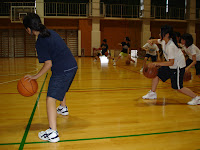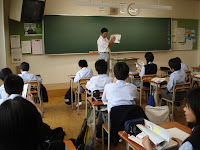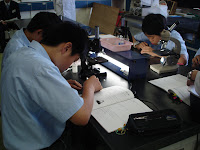
Throughout my trip, I have been describing some of the similarities and differences that I've found between schools in the United States and schools in Japan. Today, I, once again, saw something amazing at the Hijirigaoka school that I've never seen in the United States.
Hijirigaoka is a private junior high/senior high school in Tama, but I've seen this same amazing thing happen at all of the schools I've visited. In the picture above, the girls are running their own basketball practice without adult supervision and without adults having to push them.
On the other end of the gym, these junior high boys are doing the same thing.

Normally, the boys have a coach, but he was busy today, so the kids ran their own practice. One of the kids took over, and they worked as hard as if they were trying to make the team.
Two questions come to mind. One, how can kids be trusted to be alone in Japan without adult supervision, and how can kids be so disciplined that they will work hard, even without adults hovering over them.
I'm no psychologist, but I think the answer might involve the notion of self versus the group in Japan. In the United States, there is a lot of emphasis placed on the individual, but in Japan, the group is seen as more important, and it is frowned upon to let the group down.
If a player doesn't give his best effort at basketball practice, it hurts the team. From an early age, Japanese children learn to work together for the good of the team, classroom and society.
That might also explain why Japanese teachers at the elementary, junior and high school level can leave the room for several minutes without chaos breaking out. Japanese kids do a great job of policing themselves for the good of the whole.
However, I think it goes deeper than that. Before I left, I read a book about Japan written by a United States newspaper reporter who spent several years working in Japan. Like any country, Japan has its share of crime, but the crime rate is much lower than the crime rate in Europe and America. In fact, Japan is seen as one of the safest countries in the world.
The author of the book said it isn't that the Japanese legal system is overly harsh, which keeps the population in line. Instead, the author said the philosophy in Japan is people will be virtuous if you encourage them to do so. The teachers we spoke to said they don't think twice about leaving their children alone in the room because they expect the kids to act appropriately, and they normally do.
I'm not sure if this would ever work in the United States because educators always face the fear of litigation. That's one of the main reasons why we can't ever leave our kids alone, but it is an interesting question to ponder. What if, as a society, we also expected one another to be virtuous. Would we respond? Hmmmmmm!
I digress.

Today, we had a chance to look at our first private school in Tama. Elementary and junior high are free in Japan, but there's a fee for high school, since high school is not compulsory in Japan, although most students attend and graduate from high school. In Tama, a public high school costs about $1,800 a year. We were told Hijirigaoka runs about $7,000-8,000 a year.
What's different at private schools in Japan? The teachers say there are more class offerings, better discipline.....


and more extracurricular activities.

There's one another difference between high schools in Japan and the United States. Normally, students must bring their own lunch.
This is not meant as a criticism, but the one thing that has surprised me about Japanese schools is the lack of technology. All of the schools we visited have a computer lab, however, I did not see computers in individual rooms. I believe our schools in the United States, by and large, have a lot more technology.
In my school, Southeast Whitfield High School, each teacher has a laptop computer, and most rooms have projectors and other devices like slates or "Smart Boards." Part of this is due to state and county efforts, but my principal has also made a big effort to put more technology into the hands of teachers. This blog would not have been possible without our school's equipment.
Many of my fellow teachers on this trip also said they were struck by the lack of technology in Japanese schools, although that has certainly not stopped Japan from having one of the best school systems in the world.
I hope you'll keep reading my blog and sharing your comments.
